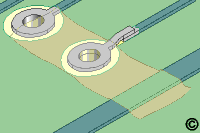No. 4.5.1
Land Repair, Epoxy Method
OUTLINE
This method is used to replace damaged and lifted lands. The damaged lands
are replaced with new lands. The new lands are bonded to the circuit board surface
using epoxy.
CAUTION
This method is used to replace a damaged or missing land, but the new land will
not have an intermetallic connection to the remaining plated hole. The solder
joint of the replaced component will restore the electrical connection.
CAUTION
It is essential that the board surface be smooth and flat. If the base board is
damaged see appropriate procedure.
NOTE
This method uses new lands that are fabricated from copper foil. They are
available in hundreds of sizes and shapes and are generally supplied solder
plated. If a special size or shape is needed it can be custom fabricated.
TOOLS & MATERIALS
Bonding System
Circuit Frames, Lands
Cleaner
Convection Oven
Epoxy
Flux, Liquid
Knife
Land Repair Kit
Microscope
Scraper
Solder
Soldering Iron
Tape, Kapton
Tweezers
Wipes
PROCEDURE
- Clean the area
- Remove the defective land and a short length of the connecting circuit if
any. (See Figure 1).
- Use the knife and scrape off any epoxy residue, contamination or
burned material from the board surface.
CAUTION
Abrasion operations can generate electrostatic charges.
- Scrape off any solder mask or coating from the connecting circuit. (See
Figure 1).
- Clean the area
- Apply a small amount of liquid flux to the connection area on the board
surface and tin with solder. Clean the area. The length of the overlap solder
connection should be a minimum of 2 times the circuit width.
- The area for the new pad on the board surface must be smooth and flat. If
internal fibers of the board are exposed or if there are deep scratches in the
surface they should be repaired. Refer to appropriate procedure.
- Select a replacement land that most closely matches the land to be replaced.
(See Figure 2).
- Cut out and trim the new land. Cut the length to provide the maximum
allowable circuit overlap for soldering. Minimum 2 times the circuit width. (See
Figure 3).
NOTE
The new replacement land may be trimmed from copper sheet.
- Mix the epoxy and apply a small amount to the surface where the new land
will be placed.
- Place a piece of Kapton tape over the top surface of the land. Place the new
land into position on the circuit board surface using the Kapton tape to aid in alignment.
(See Figure 4).
- Cure the epoxy per Procedure 2.7 Epoxy Mixing and Handling.
- After the epoxy has cured, remove the Kapton tape used for the alignment. Carefully
clean the area and inspect the new land for proper alignment.
- If the new land has a connecting circuit apply a small amount of liquid flux
to the lap solder joint connection area and solder the circuit from the new land
to the circuit on the circuit board surface. Use minimal flux and solder to ensure a
reliable connection. Tape may be placed over the top of the new land to prevent
excess solder.
NOTE
If the configuration permits, the overlap solder joint connection should be a
minimum of 3.00 mm (0.125") from the related termination. This gap will
minimize the possibility of simultaneous reflow during soldering operations.
Refer to 7.1 Soldering Basics.
- Remove Kapton tape and clean the area.
- Mix the epoxy and coat the lap solder joint connections. Cure the epoxy per
Procedure 2.7 Epoxy Mixing and Handling.
NOTE
Additional epoxy can be applied around the perimeter of the new land to provide
additional bond strength.
CAUTION
Some components may be sensitive to high temperature.
- Carefully remove any excess epoxy inside the plated hole using a ball mill
or drill bit. Turn the ball mill or drill bit by hand to prevent damage to the
wall of the plated through hole.
- Install the proper component and solder in place.
NOTE
This method is used to replace a damaged or missing land, but the new land will
not have an intermetallic connection to the remaining plated hole. The solder
joint of the replaced component will restore the integrity of the electrical
connection or an eyelet or buss wire may be used. See Plated Hole Repair
Procedures.
- Apply surface coating to match prior coating as required.
EVALUATION
- Visual examination.
- Measurement of new pad width and spacing.
- Electrical continuity measurement.
|







